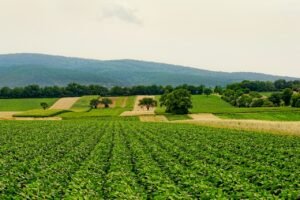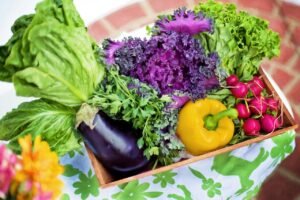
Living in a city with extreme climates comes with its own set of challenges, especially when it comes to urban farming. From scorching heat to freezing temperatures, these extreme weather conditions can make it daunting for urban farmers to grow and maintain their crops. However, with determination and a few innovative solutions, these challenges can be overcome, allowing urban farming to thrive even in the harshest of climates. In this article, we will explore the various obstacles faced by urban farmers in extreme climates and discuss practical strategies to overcome them. So, get ready to discover how urban farmers are defying the odds and growing food sustainably in the most challenging environments.

Water scarcity
Importance of water in urban farming
Water is a vital resource for urban farming, as it plays a crucial role in the growth and development of plants. Adequate water supply is essential to ensure healthy crops and high yields. In extreme climates, where water scarcity is a major concern, it becomes even more important to address this issue effectively. Without sufficient water, plants can suffer from dehydration, stunted growth, and reduced productivity.
Ways to address water scarcity
To overcome the challenges of water scarcity in urban farming, various methods can be employed. One effective approach is the implementation of water-efficient irrigation systems, such as drip irrigation or hydroponics. These systems minimize water wastage by delivering water directly to the roots of the plants, reducing evaporation and runoff. Additionally, rainwater harvesting can be utilized to collect and store rainwater for irrigation purposes. This not only conserves water but also reduces reliance on traditional water sources.
Utilizing alternative sources of water
In extreme climates, where traditional water sources may be limited, it is crucial to explore alternative sources of water for urban farming. Greywater recycling is one approach that involves treating and reusing water from sinks, showers, and laundry for irrigation. This helps to reduce the demand for freshwater while also minimizing wastewater discharge. Another alternative is the use of treated wastewater, which can be used for irrigation after undergoing appropriate treatment processes. Additionally, exploring the possibility of utilizing desalinated seawater can provide a reliable source of water in coastal urban farming areas.
Temperature regulation
Effects of extreme temperatures on crops
Extreme temperatures, whether excessively hot or cold, can have detrimental effects on crop growth and productivity. High temperatures can lead to heat stress in plants, causing wilting, leaf discoloration, and reduced photosynthesis. On the other hand, low temperatures can inhibit plant growth, damage tissues, and increase the risk of frost damage. Therefore, effective temperature regulation is crucial for maintaining optimal growing conditions and ensuring crop success in extreme climates.
Implementing shade structures and ventilation systems
To mitigate the negative effects of extreme temperatures, shade structures and ventilation systems can be implemented in urban farming setups. Shade structures, such as shade cloths or retractable canopies, can provide protection from excessive heat by reducing direct sunlight exposure. This helps to maintain cooler temperatures and prevent heat stress in plants. Ventilation systems, such as fans or greenhouse ventilation, can facilitate air movement and prevent the buildup of hot air, allowing for better temperature regulation within the growing environment.
Utilizing innovative cooling and heating techniques
In extreme climates, it is important to employ innovative cooling and heating techniques to ensure plant survival and optimal growth. Evaporative cooling systems, such as misting or fogging systems, can be used to lower temperatures and increase humidity in hot climates. This provides a more favorable environment for plants and helps to alleviate heat stress. In colder climates, heating systems such as radiant heaters or geothermal heating can be utilized to maintain optimal temperatures and protect crops from frost or freezing conditions.

Limited space
Challenges of space constraint in urban farming
One of the major challenges in urban farming is the limited availability of space. Urban areas are often characterized by high population density and limited open land, making it difficult to find suitable areas for farming. This constraint poses a significant challenge for urban farmers who need to maximize their production in limited space.
Vertical farming as a space-saving solution
Vertical farming has emerged as a space-saving solution for urban farming. This innovative technique involves growing crops in vertically stacked layers or vertical towers, utilizing vertical space efficiently. By utilizing techniques such as hydroponics or aeroponics, crops can be grown without soil, further reducing the space required. Vertical farming not only maximizes the use of available space but also enables year-round cultivation and reduces the need for large expanses of land.
Utilizing rooftops and unused areas for cultivation
Another way to overcome space constraints in urban farming is by utilizing rooftops and unused areas for cultivation. Rooftop gardens and green roofs have gained popularity as they utilize previously unused space to grow crops. Unused areas such as abandoned lots or empty buildings can also be repurposed for urban farming. By creatively utilizing available space, urban farmers can expand their production and contribute to food security in densely populated areas.
Soil quality and contamination
Importance of soil quality for successful farming
Soil quality plays a critical role in the success of urban farming. Healthy soil provides essential nutrients, retains moisture, and supports plant growth. However, urban areas often have degraded or contaminated soils due to previous land uses, pollution, or lack of proper soil management. Therefore, it is crucial to address soil quality concerns to ensure successful farming in urban environments.
Challenges of soil contamination in urban areas
Urban areas are prone to soil contamination from various sources, including industrial activities, pollution, and improper waste disposal. Contaminants such as heavy metals, pesticides, and industrial pollutants can accumulate in the soil, posing risks to plant health and food safety. Soil compaction and erosion are also common issues in urban areas, adversely affecting soil fertility and structure. These challenges need to be addressed to ensure healthy soil ecosystems and sustainable urban farming practices.
Implementing soil remediation techniques
To overcome soil quality issues, urban farmers can implement soil remediation techniques. Soil testing and analysis can provide valuable insights into the ecological health of the soil and the presence of contaminants. Remediation methods such as phytoremediation, which involves using specific plants to extract or break down contaminants, can be employed to detoxify the soil. Composting, adding organic matter, and soil aeration techniques can enhance soil fertility and structure. Implementing proper waste management practices and avoiding the use of harmful chemicals can also contribute to maintaining healthy soil in urban farming.

Pest and disease management
Unique challenges of pest and disease control in urban farming
Pest and disease management in urban farming can be particularly challenging due to the proximity of crops, high population density, and limited space. Urban environments often promote the proliferation of pests and diseases, which can spread quickly and cause significant damage to crops. Additionally, the use of chemical pesticides may be restricted in urban areas due to potential health and environmental concerns. Therefore, adopting effective and sustainable pest and disease management strategies is essential for urban farmers.
Implementing integrated pest management strategies
Integrated Pest Management (IPM) is an approach that emphasizes the use of multiple pest management techniques to minimize the reliance on chemical pesticides. IPM involves monitoring pest populations, identifying pest species, and employing various control methods such as biological control, cultural practices, and physical barriers. This approach aims to strike a balance between pest control and environmental sustainability, ensuring the long-term health and productivity of urban farming systems.
Utilizing natural predators and biological controls
In urban farming, harnessing the power of natural predators and biological controls can be an effective way to manage pests. Beneficial insects, such as ladybugs or lacewings, can be introduced to the farming system to control pest populations naturally. Additionally, using biological control agents, such as nematodes or fungi, can help to suppress pest populations without the use of synthetic chemicals. Encouraging biodiversity and creating habitats for natural enemies of pests can contribute to a balanced ecosystem that naturally controls pest populations.
Limited access to sunlight
Impact of low sunlight availability on plant growth
Limited access to sunlight can be a significant challenge for urban farming, particularly in areas with tall buildings, shading structures, or dense tree cover. Sunlight is essential for photosynthesis, the process through which plants convert sunlight into energy for growth and development. Insufficient sunlight availability can result in stunted growth, decreased yields, and leggy plants with weak stems. Therefore, finding solutions to maximize sunlight exposure is crucial for successful urban farming.
Utilizing artificial lighting solutions
To overcome the limitations of low sunlight availability, artificial lighting solutions can be employed in urban farming setups. Supplemental lighting, such as LED grow lights, can provide the necessary light spectrum and intensity required for plant growth. By strategically placing and configuring artificial lights, farmers can ensure that plants receive an adequate amount of light for photosynthesis. This allows for year-round cultivation and the ability to grow light-demanding crops in urban environments regardless of natural light conditions.
Adapting crops to low light conditions
Another approach to addressing limited access to sunlight is by selecting and adapting crops that are tolerant to low light conditions. Some plant species have higher shade tolerance, allowing them to perform better in areas with reduced sunlight. By choosing shade-tolerant varieties, urban farmers can optimize the use of available light and maximize productivity even in areas with limited sunlight. Additionally, implementing reflective surfaces or using light-colored materials in farming structures can help to optimize light distribution and utilization within the growing environment.

Energy consumption
Energy demands of urban farming systems
Urban farming systems often require significant energy inputs for various operations such as lighting, temperature control, irrigation, and equipment. High energy consumption can contribute to greenhouse gas emissions and increase the environmental footprint of urban farming. It is important to address energy demands and explore sustainable solutions to reduce energy consumption in urban farming.
Implementing energy-efficient technologies
One way to reduce energy consumption in urban farming is by implementing energy-efficient technologies and practices. Using energy-efficient LED grow lights, for example, can significantly reduce electricity usage compared to traditional lighting systems. Energy-saving equipment, such as efficient irrigation pumps or climate control systems, can also help to minimize energy requirements. Additionally, optimizing the use of energy through proper scheduling, automation, and monitoring systems can help to further reduce energy consumption in urban farming operations.
Utilizing renewable energy sources
To promote sustainability and reduce reliance on fossil fuels, urban farmers can consider utilizing renewable energy sources to meet their energy needs. Solar panels can be installed on rooftops or other unused areas to generate clean solar energy for powering farming operations. Wind turbines or biogas digesters can also be explored as alternative renewable energy sources. By harnessing renewable energy, urban farmers can reduce their carbon footprint and contribute to a greener and more sustainable future.
Growth and yield optimization
Optimizing crop growth in extreme climates
In extreme climates, it is essential to optimize crop growth and maximize yields to ensure a successful urban farming operation. Crop growth optimization involves creating and maintaining the most favorable growing conditions to promote healthy plant development and productivity. This is particularly important in regions with harsh climatic conditions, where plant survival and growth can be challenging.
Developing climate-tailored farming techniques
To optimize crop growth in extreme climates, it is crucial to develop farming techniques specifically tailored to the local climatic conditions. This includes selecting appropriate crop varieties that are adapted to the specific climate, temperature, and humidity ranges. Understanding the microclimates within the urban environment and adapting farming practices accordingly can also help to optimize growing conditions. Implementing techniques such as mulching, shading, or windbreaks can provide protection and create microenvironmental conditions that favor plant growth.
Utilizing advanced monitoring and control systems
The use of advanced monitoring and control systems can greatly enhance crop growth optimization in urban farming. Technological innovations such as sensor-based monitoring systems can provide real-time data on environmental conditions, allowing farmers to make informed decisions and adjust growing parameters accordingly. Automated control systems can regulate temperature, humidity, irrigation, and nutrient delivery, ensuring optimal conditions for crop growth. These technologies help to optimize resource utilization and maximize yields, even in challenging urban farming environments.

Community engagement and education
Importance of community involvement in urban farming
Community involvement is crucial for the success and sustainability of urban farming initiatives. Engaging the local community creates a sense of ownership, fosters support, and promotes the exchange of knowledge and resources. By involving residents, schools, and local organizations, urban farmers can build stronger relationships, create a sense of food security, and enhance the overall well-being of the community.
Educating the community about urban farming benefits
To foster community involvement, it is important to educate the community about the benefits of urban farming. Raising awareness about the positive impacts of local food production, such as improved access to fresh and nutritious produce, reduced food miles, and enhanced environmental sustainability, can encourage community members to participate in and support urban farming initiatives. Workshops, seminars, and educational campaigns can be organized to share knowledge and inspire individuals to get involved in urban farming practices.
Establishing community gardens and educational programs
Establishing community gardens and educational programs is an effective way to engage and educate the community about urban farming. Community gardens provide hands-on learning opportunities, allowing residents to actively participate in the cultivation of crops and experience the rewards of their efforts. Educational programs can be designed to teach gardening techniques, sustainable farming practices, and the importance of healthy eating. By creating spaces for communal learning and collaboration, urban farmers can empower the community to become actively involved in urban agriculture and promote food security at the local level.
Economic viability
Challenges of economic sustainability in urban farming
Achieving economic sustainability is a significant challenge in urban farming. High land costs, limited space, and increased competition can make it difficult for urban farmers to achieve profitability. Additionally, urban farmers face the pressure of producing enough to meet market demands while maintaining affordable prices. Overcoming these economic challenges is crucial for the long-term viability and success of urban farming enterprises.
Implementing cost-effective production methods
To improve economic sustainability, urban farmers can focus on implementing cost-effective production methods. This includes maximizing efficiency in resource utilization, optimizing crop selection based on market demand and profitability, and minimizing waste. For example, employing hydroponic or aeroponic systems can reduce water and fertilizer usage while maximizing yields. Vertical farming techniques can maximize space utilization and increase productivity per square foot. By identifying and implementing production methods that are economically efficient, urban farmers can reduce costs and increase profitability.
Exploring diverse revenue streams
To enhance economic viability, urban farmers can explore diverse revenue streams beyond traditional crop sales. Value-added products, such as processed foods, juices, or preserves, can provide higher profit margins compared to raw produce. Selling produce directly to consumers through farmers’ markets, community-supported agriculture (CSA) programs, or online platforms can eliminate middlemen and increase profitability. Additionally, offering educational workshops, agritourism activities, or farm-to-table experiences can generate additional income and create a unique selling proposition. By diversifying revenue streams, urban farmers can improve economic sustainability and build resilience in their farming enterprises.







